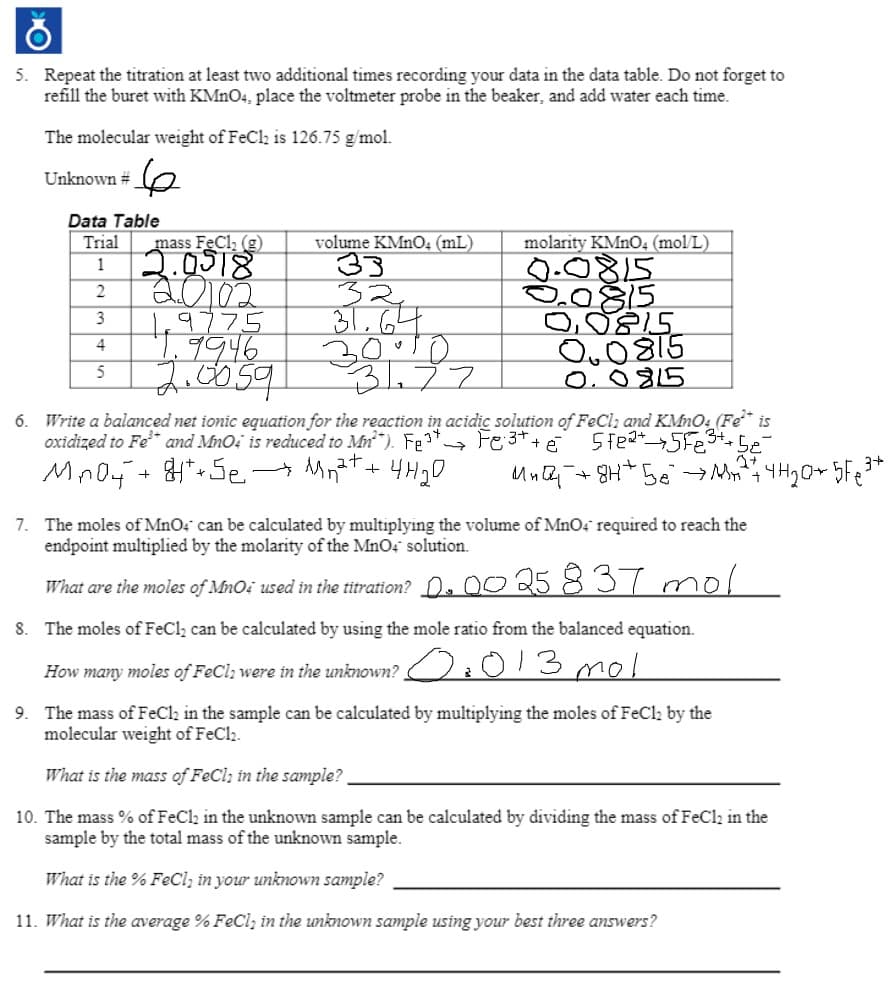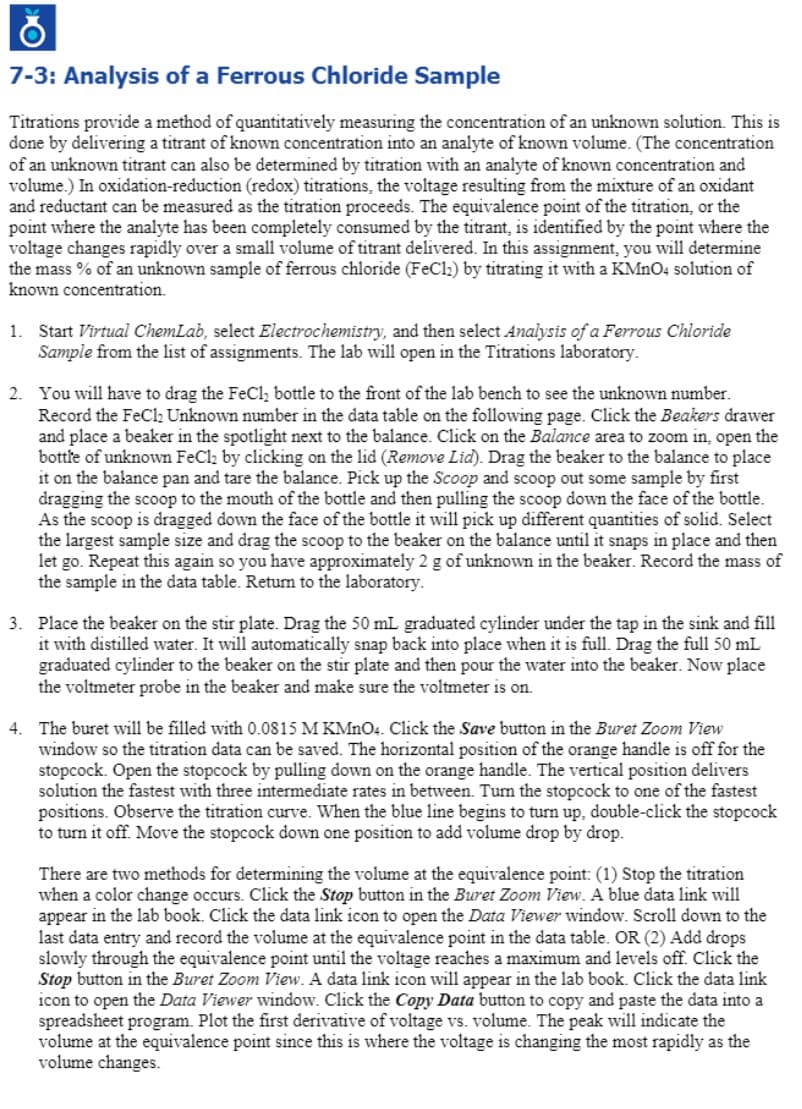many mole 9. The mass of FeCl, in the sample can be calculated by multiplying the moles of FeCl, by the molecular weight of FeCl2. What is the mass of FeCl; in the sample?. 10. The mass % of FeCl, in the unknown sample can be calculated by dividing the mass of FeCl; in the sample by the total mass of the unknown sample. What is the % FeCl; in your unknown sample? 11. What is the average % FeCl, in the unknown sample using your best three answers?
many mole 9. The mass of FeCl, in the sample can be calculated by multiplying the moles of FeCl, by the molecular weight of FeCl2. What is the mass of FeCl; in the sample?. 10. The mass % of FeCl, in the unknown sample can be calculated by dividing the mass of FeCl; in the sample by the total mass of the unknown sample. What is the % FeCl; in your unknown sample? 11. What is the average % FeCl, in the unknown sample using your best three answers?
Principles of Instrumental Analysis
7th Edition
ISBN:9781305577213
Author:Douglas A. Skoog, F. James Holler, Stanley R. Crouch
Publisher:Douglas A. Skoog, F. James Holler, Stanley R. Crouch
Chapter23: Potentiometry
Section: Chapter Questions
Problem 23.14QAP
Related questions
Question

Transcribed Image Text:5. Repeat the titration at least two additional times recording your data in the data table. Do not forget to
refill the buret with KMNO4, place the voltmeter probe in the beaker, and add water each time.
The molecular weight of FeCl, is 126.75 g/mol.
Unknown #
Data Table
Trial
mass FeCl, (g)
volume KMNO4 (mL)
molarity KMNO, (mol/L)
2.0518
20102
+9775
1.9946
33
Q.0815
1
33
31.64
2
3
1800
4
5
6. Write a balanced net ionic equation for the reaction in acidic solution of FeCl; and KMnOs (Fe* is
oxidized to Fe* and MnOi is reduced to Mn). Fe + e
Se
3+
MnOy+ 8*+Se
7. The moles of MnO4 can be calculated by multiplying the volume of MnO4 required to reach the
endpoint multiplied by the molarity of the MnO4 solution.
What are the moles of MnOi used in the titration? D, OC 25 8 37 mol
8. The moles of FeCl, can be calculated by using the mole ratio from the balanced equation.
How many moles of FeCl; were in the unknown? O:013 ol
9. The mass of FeCl2 in the sample can be calculated by multiplying the moles of FeCl, by the
molecular weight of FeCl2.
What is the mass of FeCl; in the sample?
10. The mass % of FeCl, in the unknown sample can be calculated by dividing the mass of FeCl, in the
sample by the total mass of the unknown sample.
What is the % FeCl; in your unkmown sample?
11. What is the average % FeCl; in the unknown sample using your best three answers?

Transcribed Image Text:7-3: Analysis of a Ferrous Chloride Sample
Titrations provide a method of quantitatively measuring the concentration of an unknown solution. This is
done by delivering a titrant of known concentration into an analyte of known volume. (The concentration
of an unknown titrant can also be determined by titration with an analyte of known concentration and
volume.) In oxidation-reduction (redox) titrations, the voltage resulting from the mixture of an oxidant
and reductant can be measured as the titration proceeds. The equivalence point of the titration, or the
point where the analyte has been completely consumed by the titrant, is identified by the point where the
voltage changes rapidly over a small volume of titrant delivered. In this assignment, you will determine
the mass % of an unknown sample of ferrous chloride (FeCl2) by titrating it with a KMNO4 solution of
known concentration.
Start Virtual ChemLab, select Electrochemistry, and then select Analysis of a Ferrous Chloride
Sample from the list of assignments. The lab will open in the Titrations laboratory.
1
2. You will have to drag the FeCl, bottle to the front of the lab bench to see the unknown number.
Record the FeCl Unknown number in the data table on the following page. Click the Beakers drawer
and place a beaker in the spotlight next to the balance. Click on the Balance area to zoom in, open the
bottle of unknown FeCl, by clicking on the lid (Remove Lid). Drag the beaker to the balance to place
it on the balance pan and tare the balance. Pick up the Scoop and scoop out some sample by first
dragging the scoop to the mouth of the bottle and then pulling the scoop down the face of the bottle.
As the scoop is dragged down the face of the bottle it will pick up different quantities of solid. Select
the largest sample size and drag the scoop to the beaker on the balance until it snaps in place and then
let go. Repeat this again so you have approximately 2 g of unknown in the beaker. Record the mass of
the sample in the data table. Retum to the laboratory.
3. Place the beaker on the stir plate. Drag the 50 mL graduated cylinder under the tap in the sink and fill
it with distilled water. It will automatically snap back into place when it is full. Drag the full 50 mL
graduated cylinder to the beaker on the stir plate and then pour the water into the beaker. Now place
the voltmeter probe in the beaker and make sure the voltmeter is on.
4.
The buret will be filled with 0.0815 M KMNO4. Click the Save button in the Buret Zoom View
window so the titration data can be saved. The horizontal position of the orange handle is off for the
stopcock. Open the stopcock by pulling down on the orange handle. The vertical position delivers
solution the fastest with three intermediate rates in between. Tum the stopcock to one of the fastest
positions. Observe the titration curve. When the blue line begins to turn up, double-click the stopcock
to turn it off. Move the stopcock down one position to add volume drop by drop.
There are two methods for determining the volume at the equivalence point: (1) Stop the titration
when a color change occurs. Click the Stop button in the Buret Zoom View. A blue data link will
appear in the lab book. Click the data link icon to open the Data Viewer window. Scroll down to the
last data entry and record the volume at the equivalence point in the data table. OR (2) Add drops
slowly through the equivalence point until the voltage reaches a maximum and levels off. Click the
Stop button in the Buret Zoom View. A data link icon will appear in the lab book. Click the data link
icon to open the Data Viewer window. Click the Copy Data button to copy and paste the data into a
spreadsheet program. Plot the first derivative of voltage vs. volume. The peak will indicate the
volume at the equivalence point since this is where the voltage is changing the most rapidly as the
volume changes.
Expert Solution
This question has been solved!
Explore an expertly crafted, step-by-step solution for a thorough understanding of key concepts.
This is a popular solution!
Trending now
This is a popular solution!
Step by step
Solved in 2 steps

Knowledge Booster
Learn more about
Need a deep-dive on the concept behind this application? Look no further. Learn more about this topic, chemistry and related others by exploring similar questions and additional content below.Recommended textbooks for you

Principles of Instrumental Analysis
Chemistry
ISBN:
9781305577213
Author:
Douglas A. Skoog, F. James Holler, Stanley R. Crouch
Publisher:
Cengage Learning

Principles of Modern Chemistry
Chemistry
ISBN:
9781305079113
Author:
David W. Oxtoby, H. Pat Gillis, Laurie J. Butler
Publisher:
Cengage Learning


Principles of Instrumental Analysis
Chemistry
ISBN:
9781305577213
Author:
Douglas A. Skoog, F. James Holler, Stanley R. Crouch
Publisher:
Cengage Learning

Principles of Modern Chemistry
Chemistry
ISBN:
9781305079113
Author:
David W. Oxtoby, H. Pat Gillis, Laurie J. Butler
Publisher:
Cengage Learning

